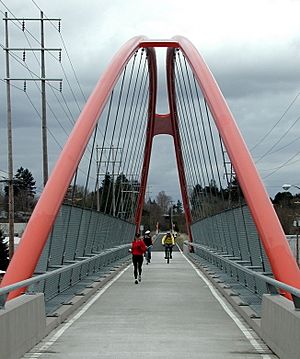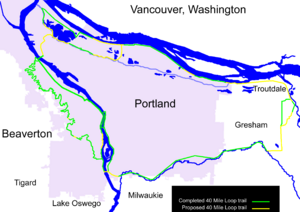40-Mile Loop facts for kids

The 40-Mile Loop is a special path for walking and biking that goes around and through Portland, in the U.S. state of Oregon. It's called a "greenway trail" because it connects many green spaces and parks. This big idea was first suggested in 1903 by the Olmsted Brothers, who were famous for designing parks.
One expert who studies greenways has called it "one of the most creative and resourceful greenway projects in the country."
Even though it's called the "40-Mile Loop," the path is actually much longer now, about 140 miles (225 km)! It connects more than thirty city parks. Also, it's not a perfect "loop" anymore. There are several smaller loops, shortcuts, and paths that branch off from the main trail. One of these paths is planned to connect all the way to the Pacific Crest Trail, a very long hiking trail.
History of the Loop
In 1903, the Parks Board in Portland invited the Olmsted Brothers to help plan how to make the city more beautiful. This was part of getting ready for a big fair called the Lewis and Clark Centennial Exposition in 1905. The Olmsted Brothers looked at the city's parks and came up with a big idea: instead of just having parks scattered around, they suggested a network of parks and paths connected together all around the city. They said, "A connected system of parks and parkways is clearly much more complete and useful than a series of separate parks." When they were trying to name this system, one brother asked the other, "What would you call a forty-mile loop?" Since their firm was known for simple names, they just stuck with that!
Not much happened with the plan until 1907. That year, people in the city voted to approve a $1 million bond measure. This was a way for the city to borrow money to develop existing parks. In 1912, another city planner named Edward H. Bennett also suggested building a park along the top of the West Hills. However, a plan to borrow $2 million to buy the land needed for this was voted down by the people. But soon after, much of the land in Forest Park became property of the city or Multnomah County because of unpaid taxes and a landslide.
In 1943, an important city planner named Robert Moses was hired. He suggested creating Forest Park. After several years of discussion, the park was finally created in 1948. It was made from land the city got because of unpaid taxes, donations, and by buying it. This park contained the first part of the 40-mile loop.
Then, not much progress was made until 1978. At the request of Oregon lawmakers, the U.S. Congress changed the rules so the Columbia Slough wasn't used for big boats anymore. This allowed the land to be used for fun activities like walking and biking, which was an important part of the original Olmsted plan. The Oregon director of the Nature Conservancy saw that there was less money from the government for parks. So, he decided to bring the loop plan back. People from the city, nearby towns, government agencies, conservation groups, and other community groups loved the idea!
This group eventually formed the 40-Mile Loop Land Trust. This trust was very good at getting 13 different government groups, who usually didn't work together, to team up. It also helped move land from one group to another.
One of the Land Trust's big successes was getting the Southern Pacific and Union Pacific railroads to work together. These two companies owned the abandoned Springwater Corridor trail. In 1990, they transferred the land to the Trust. This was a big step forward in completing the loop.
Exploring the Trail
The 40-Mile Loop has many different kinds of parts. Some sections are on flat ground, like along the Columbia River. Other parts have lots of trees and hills, like through Washington Park's Hoyt Arboretum.
All parts of the trail are good for walking and hiking. Most of the trail is also open for bicycling. There are also places where you can use strollers, wheelchairs, skates, skateboards, ride horses, or go canoeing and kayaking.
Places You Can See
Here are some of the cool places you can see along the 40-Mile Loop:
- St. Johns Bridge
- Kelley Point Park
- N. and NE Marine Drive along the south bank of the Columbia River
- Smith and Bybee Wetlands Natural Area
- Columbia Slough
- Blue Lake Park
- Troutdale, Oregon
- Mount Hood Community College
- Gresham, Oregon
- Springwater Corridor
- Gresham Main City Park
- Gresham Butte
- Powell Butte Nature Park
- Leach Botanical Garden
- Tideman Johnson Natural Area
- Sellwood Park
- Sellwood Riverfront Park
- Oaks Amusement Park
- Oaks Bottom Wildlife Refuge
- Eastbank Esplanade
- Hawthorne Bridge
- Steel Bridge
- I-205 Bike Path
- Sellwood Bridge
- Willamette Greenway
- Wildwood Trail
What's Next for the Loop?
The Springwater Corridor is a part of the 40-Mile Loop that goes out to the east, through Gresham and into Boring. Metro, a local government group, wants to build the Cazadero Trail. This new trail would extend the Springwater Corridor another 2 miles (3.2 km) past Estacada. The goal is for it to eventually connect to the Pacific Crest Trail.



